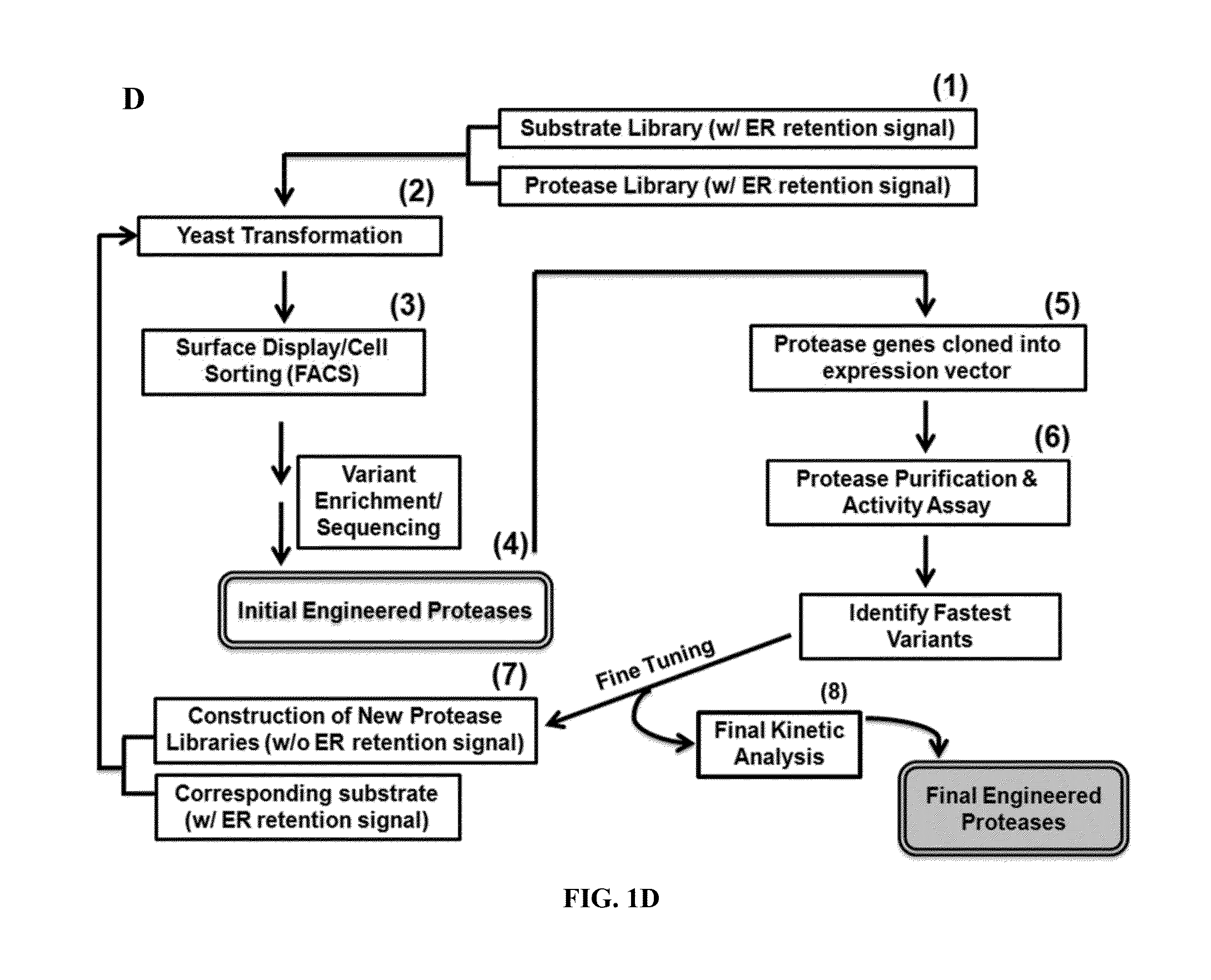Method for engineering proteases and protein kinases
a technology of proteases and protein kinases, applied in the field of therapeutic proteases, can solve the problems of limited list of potential practical applications of proteases, inability to consider general approaches, and two substantial challenges to achieve the effect of increasing activity
- Summary
- Abstract
- Description
- Claims
- Application Information
AI Technical Summary
Benefits of technology
Problems solved by technology
Method used
Image
Examples
example 1
Materials and Methods
Construction and Transformation of Yeast Vectors for Library Sorting
[0155]The pESD plasmid was constructed based on the pCTCon2 (generously contributed by Dr. Dane K. Wittrup at MIT) and the pESC-TRP vectors (Agilent Technologies, Santa Clara Calif.; generously contributed by Dr. Edward W. Marcotte at UT Austin) (FIG. 6). The GAL1 / 10 bidirectional promoter in the pCTCon2 plasmid was replaced by the dual GAL1-GAL10 promoter that transcribes in both directions, establishing a co-expressing system. The strength ratio of the GAL1:GAL10 in this bi-directional promoter is around 0.8:1.0 based on the company manual. The TEV-P substrate library was inserted downstream of the GAL10 promoter in the pESD vector. Under the control of the GAL10 promoter and after the Aga2 gene used for yeast surface display, a five-part cassette was cloned consisting of (1) the native substrate of TEV-P, ENLYFQS (SEQ ID NO:18); (2) a FLAG tag, DYKDDDDK (SEQ ID NO:22); (3) the designed peptid...
example 2
Protease Engineering Using Yeast ER Sequestering (YESS)
[0170]YESS Method Validation
[0171]The expression of both the protease and substrate as separate fusions allows for at least three different types of experiments using the YESS format. A single new substrate can be used as the selection substrate along with one or more counter selection substrates in the presence of a protease library in order to isolate a protease variant with a desired new sequence specificity. Alternatively, a single protease of interest can be used with a library of substrate sequences in order to profile protease cleavage positional specificity. Finally, a “library-on-library” approach can be used in which a library of proteases is expressed in conjunction with a library of substrates, potentially increasing the odds of identifying highly active / specific new engineered protease-substrate pairs.
[0172]A number of experiments were carried out to validate the YESS system. Throughout, the TEV-P was used as a mode...
PUM
| Property | Measurement | Unit |
|---|---|---|
| pH | aaaaa | aaaaa |
| volume | aaaaa | aaaaa |
| temperature | aaaaa | aaaaa |
Abstract
Description
Claims
Application Information
 Login to View More
Login to View More - R&D
- Intellectual Property
- Life Sciences
- Materials
- Tech Scout
- Unparalleled Data Quality
- Higher Quality Content
- 60% Fewer Hallucinations
Browse by: Latest US Patents, China's latest patents, Technical Efficacy Thesaurus, Application Domain, Technology Topic, Popular Technical Reports.
© 2025 PatSnap. All rights reserved.Legal|Privacy policy|Modern Slavery Act Transparency Statement|Sitemap|About US| Contact US: help@patsnap.com



